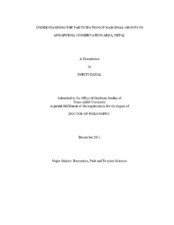| dc.description.abstract | Participation has been promoted and studied in diverse disciplines including tourism, development, planning, health, politics, and others. In natural resource conservation, the shift from centralized to decentralized decision making which emphasizes community involvement in planning, implementation and monitoring of programs has been broadly encouraged, especially in developing countries. Although considered a more effective alternative to top down decision making, participatory conservation initiatives have been criticized for many reasons, mainly the exclusion of marginalized groups in programs which lead to unequal distribution of socioeconomic benefits. This inequality is conditioned by social, physical and political structures which act as barriers to sustainable development of resources and communities.
Using a political ecology approach, this research explored the participation of marginal groups (poor, women, and lower caste) in Nepal's Annapurna Conservation Area. The main objectives of this study are: 1) To examine the perceived benefits of Annapurna Conservation Area Project (ACAP) and how marginal groups fare in the distribution of benefits; 2) To analyze the level of participation of marginal groups in local management institutions; and 3) To identify the barriers to participation as perceived by marginal groups.
Field work for this dissertation was conducted during August ? October 2010 using both quantitative and qualitative data, and employing participant observation and semi-structured interviews. Results indicate that benefits of the project were distributed unequally, and targeted towards elite members of the community. Findings also indicated that although marginal groups were involved in local management institutions, their representation was marginal and had not led to empowerment. Lastly, barriers to participation of communities were complex and deeply rooted in traditions and social norms.
Overall, the findings indicate that the definition of marginal groups go beyond gender and caste, and are more significantly defined by wealth, poverty, education, and access to information. The study concludes that ACAP needs to re-orient its conservation and development projects by adopting a more inclusive form of participation and that these projects should aim to overcome the barriers identified by the marginalized households. | en |


